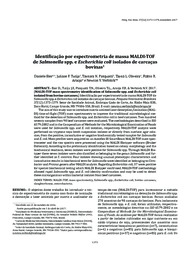Identificação por espectrometria de massa MALDI-TOF de Salmonella spp. e Escherichia coli isolados de carcaças bovinas.
Identificação por espectrometria de massa MALDI-TOF de Salmonella spp. e Escherichia coli isolados de carcaças bovinas.
Autoria: BIER, D.; TUTIJA, J. F.; PASQUATTI, T. N.; OLIVEIRA, T. L.; ARAUJO, F. R.; VERBISCK, N. V.
Resumo: The aim of this study was to introduce matrix-assisted laser desorption/ionization (MALDI) time-of-flight (TOF) mass spectrometry to improve the traditional microbiological method for the detection of Salmonella spp. and Escherichia coli in beef carcasses. Two hundred seventy samples from 90 beef carcasses were evaluated. The methodologies described in ISO 6579:2002 and in the Compendium of Methods for the Microbiological Examination of Foods were used for Salmonella spp. and E. coli isolation, respectively. MALDI-TOF analysis were performed on tryptone soya broth suspension isolates or directly from nutrient agar colonies, from the positive, inconclusive or negative biochemically tested samples for Salmonella and E. coli. Mass profiles were acquired on an Autoflex III SmartBeam MALDI-TOF mass spectrometer and the raw spectra were processed using the MALDI Biotyper software (Bruker Daltonics). According to the preliminary identification based on colony morphology and the biochemical reactions, seven isolates were positive for Salmonella spp. Through MALDI Biotyper these seven isolates were also classified as belonging to the genus Salmonella and further identified as S. enterica. Four isolates showing unusual phenotypic characteristics and inconclusive results in biochemical tests for Salmonella were identified as belonging to Citrobacter and Proteus genera after MALDI analysis. Regarding Escherichia coli, 37 were positive for species biochemical testing which MALDI Biotyper confirmed. MALDI-TOF methodology allowed rapid Salmonella spp. and E. coli identity confirmation and may be used to detect these microrganisms within bacterial isolates from beef carcasses.
Ano de publicação: 2017
Tipo de publicação: Artigo de periódico
Unidade: Embrapa Gado de Corte
Palavras-chave: Beef carcasses, Enterobacteriales, Escherichia Coli, MALDI–TOF, Mass spectrometry, Salmonella spp, Slaughterhouse
Observações
1 - Por padrão são exibidas publicações dos últimos 20 anos. Para encontrar publicações mais antigas, configure o filtro ano de publicação, colocando o ano a partir do qual você deseja encontrar publicações. O filtro está na coluna da esquerda na busca acima.
2 - Para ler algumas publicações da Embrapa (apenas as que estão em formato ePub), é necessário ter, no celular ou computador, um desses softwares gratuitos. Sistemas Android: Google Play Livros; IOS: iBooks; Windows e Linux: software Calibre.
Acesse outras publicações
Acesse a Base de Dados da Pesquisa Agropecuária (BDPA) para consultar o acervo completo das bibliotecas da Embrapa.

